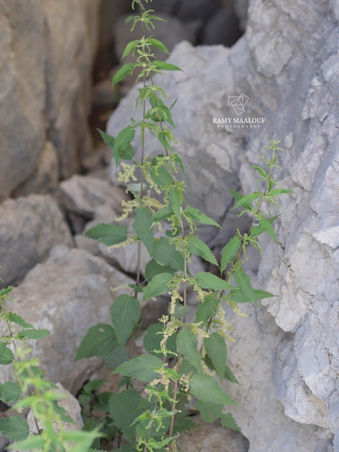Family |
Urticaceae
Urtica dioica
L.
Urtica dioica L.
(Sp. Pl.: 984; 1753. — Nouvelle Flore du Liban et de la Syrie, vol. 1, p. 374; 1966)
• Life-form & habit: Perennial, dioecious (sometimes monoecious), with short, creeping rhizome, somewhat woody. Stems erect, quadrangular, 15 cm–1 m tall, simple or few-branched, green like the foliage.
• Leaves: Opposite, oblong to oblong-lanceolate, 4–10 cm long, sharply dentate with ovate acute teeth, slightly unequal; surfaces green, with stinging hairs.
• Inflorescence & flowers: Axillary, in paired paniculiform clusters. Male inflorescences with short lateral branches; female or androgynous ones longer, erect-patent or pendulous. Flowers in dense or somewhat distant fascicles. Sepals 4, equal in staminate flowers (oval, obtuse, pubescent), unequal in pistillate ones, inner usually longer.
• Fruit: Small achenes, ovoid, compressed, glabrous.
• Phenology: Flowers April–September.
• Habitat & elevation: Rubble, especially near water sources, dolines frequented by livestock; rare or absent on the coast and at low elevations.
• Lebanese distribution: Ct. Tripoli; Mi. Ba‘abda, Broummana, Faraya; Mm. Cedars, Hadeth, Dimane to Hasroun, Jabal Kneissé; Me. Dolines of Jabal Sannine, Ouadi Safsaf; Metn: Qabbélias, Ouadi-el-‘Arayech, Jdita.
• Native range: Europe, North Africa, Canary Islands, Caucasus, Western Asia (including Lebanon–Syria, Palestine, Turkey, Iran), Central Asia, Himalaya, China, Japan, Russian Far East, and introduced widely elsewhere. (POWO)






